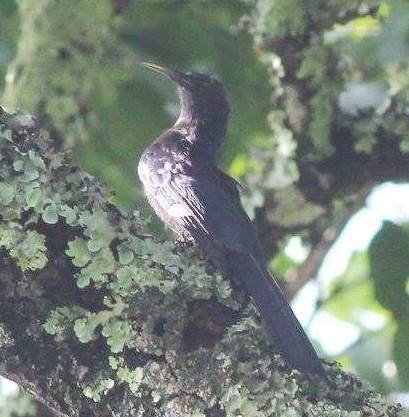Black Scimitarbill Bird Details
Rhinopomastus aterrimus
Black Scimitarbill
NA
James Francis Stephens, 1826
Bucerotiformes (HOOPOES and HORNBILLS)
Phoeniculidae
Rhinopomastus
Senegal, Gambia, Guinea-Bissau, Guinea, Sierra Leone, Liberia, Ivory Coast, Ghana, Togo, Benin, Nigeria, Cameroon, Central African Republic, Equatorial Guinea, Gabon, Congo, Democratic Republic of Congo, Uganda, Kenya, Tanzania, Zambia, Malawi, Mozambique, Zimbabwe, Botswana, Namibia, and South Africa.
Appearance :
The Black Scimitarbill is a distinctive bird with a black plumage overall. It has a long, decurved black bill with a pale base. The eyes are surrounded by bare yellow skin, and the legs are dark.
Behaviour :
It is known for its habit of perching conspicuously in the open, often on top of tall trees or poles. It can be quite vocal, producing a variety of calls including a nasal "quoo-quoo" sound.
Habitat :
It inhabits savannas, open woodlands, and wooded grasslands. It prefers areas with scattered trees and is commonly found near rivers or streams.
Diet :
The diet primarily consists of insects such as beetles, grasshoppers, and termites. It also feeds on small vertebrates and occasionally fruits.
Conservation Status :
Least Concern
Distribution :
It is found in sub-Saharan Africa, ranging from Senegal and Gambia in the west to Ethiopia and Kenya in the east, and southwards to northern South Africa.
Population Size :
Specific population estimates are not readily available.
Life Span :
Between 5 to 10 years.
Body And Tarsus:
- The Black Scimitarbill has a compact, stocky body with a predominantly black plumage.
- Tarsus Length: Around 1.8 to 1.9 cm.
Head And Bill :
- Head: The head is relatively small compared to its body size.
- Bill: It has a distinctive long, decurved black bill with a pale base. The bill length is approximately 6-8 cm (2.4-3.1 inches).
Length :
Around 23-25 cm (9-10 inches) from bill tip to tail tip.
Neck :
The neck is short and stout, blending smoothly into the body.
Size :
It is a medium-sized bird, compact and robust in appearance.
Tail Details :
- Tail: The tail is relatively short compared to other similar species of hornbills.
- Tail Length: The tail length is about 6-8 cm (2.4-3.1 inches).
Weight :
Approximately 50-70 grams (1.8-2.5 ounces).
Wing :
The wings are rounded, suitable for short flights and agile maneuvering among branches.
Wing Span :
Around 30-35 cm (11.8-13.8 inches).
Facial Feature :
The bird has distinctive bare yellow skin around the eyes, giving it a striking appearance. The eyes themselves are dark.
Nest Details :
- Nest: The nest of the Black Scimitarbill is typically located in a natural cavity of a tree or sometimes in a hole in a termite mound.
- Nest Composition: The nest is made up of twigs, leaves, and other plant material, forming a relatively simple structure compared to some other hornbill species.
Breeding Season :
Occurs during the rainy season
Nesting Season :
Generally, corresponds to periods of abundant food supply after the rains.
Egg Color :
White or pale creamy-white in color.
Egg Length :
Approximately 27-30 mm in length.
Egg Width and Weight :
- Egg Width: The width of each egg is around 20-23 mm.
- Egg Weight: The average weight of each egg is approximately 7-9 grams.
Clutch Size :
Usually consists of 2-4 eggs.
No. of Broods :
Raises a single brood per breeding season.
Incubation Period :
About 18-21 days.
Nestling Period :
About 25-30 days before fledging.
Vocalization :
The Black Scimitarbill is known for its vocalizations, which include various calls such as a nasal "quoo-quoo" sound.
Sex Demorphism :
Males and females look alike.
Migration Details :
Non-migratory Birds.






